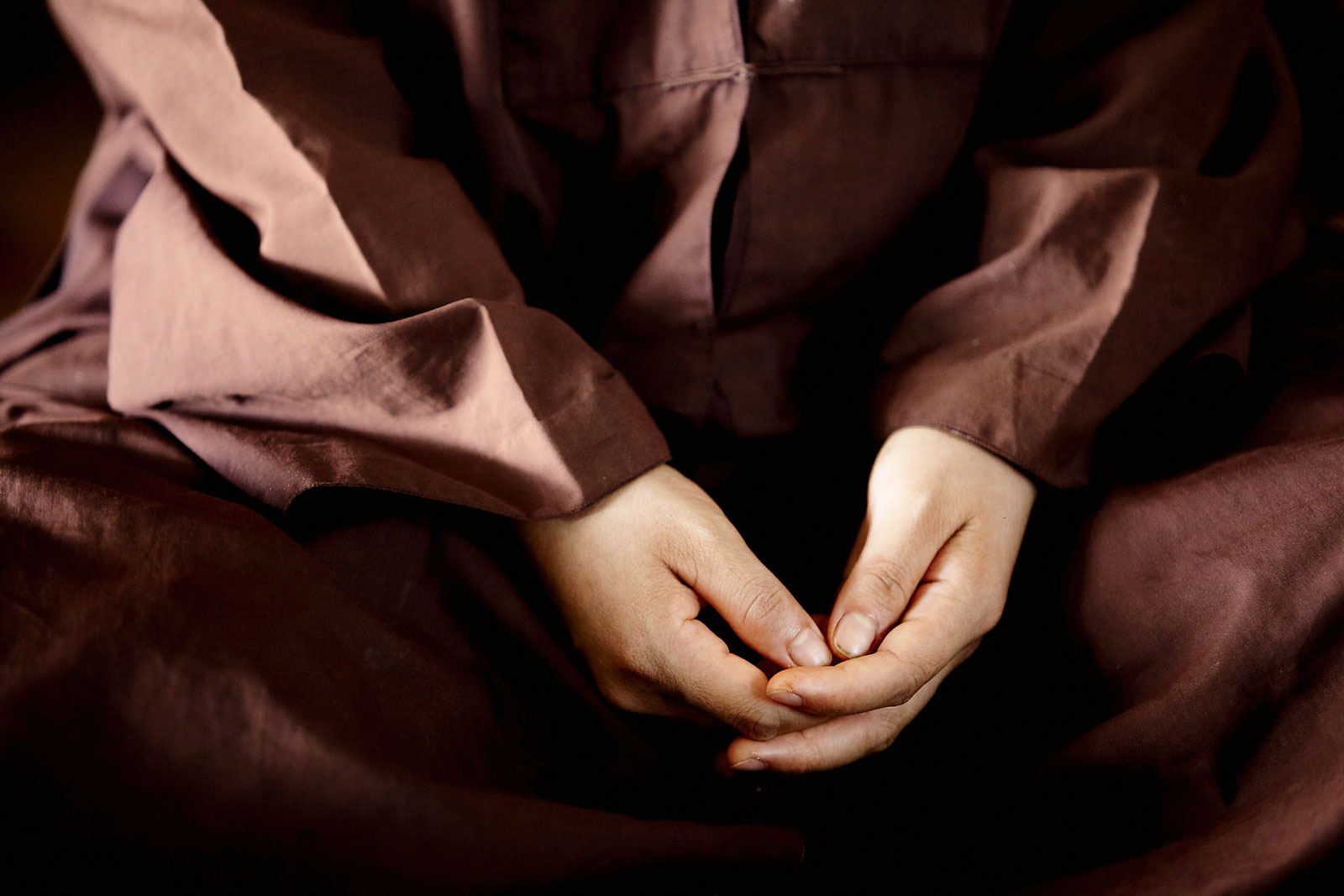When the Knives Are Out
The story of a nun who responded to rage with equanimity The post When the Knives Are Out appeared first on Tricycle: The Buddhist Review.

This article is the last in a four-part series on stories of great Buddhist nuns. Here we meet Venerable Utpalavarna, a nun who demonstrates extraordinary spiritual power even as her life is threatened by members of her own community.
What follows is a retelling of a story recorded in the Kshudrakavastu, a scripture from the canon of monastic discipline belonging to the Mulasarvastivada school of the Sanskrit-Tibetan tradition.
Venerable Utpalavarna sat in a state of peaceful equanimity, meditating beneath the canopy of a tree. A movement crossed her awareness, and briefly she glanced to the side. She saw a monk prostrating with great devotion to a nearby shrine, surrounded by a group of his students bowing along with him. Because of the great reverence they showed the stupa, Utpalavarna deduced that the monks thought they were bowing to a shrine dedicated to the Buddha himself. This was definitely not the case. Somewhat against her better judgment (monks in positions of authority did not often care to be reprimanded in front of their students by a nun), she decided to speak up.
“Venerable,” she said, “make sure you know whose shrine you’re bowing to.”
Taken aback, the monk abruptly straightened into a standing position. Why would this nun say such a thing? After a moment’s reflection, he realized that this shrine must not be one dedicated to the Buddha, but rather some other spiritual teacher. He felt embarrassed to be seen making a mistake, particularly in front of his students. Worse, there was a rule against nuns disparaging monks, and although Venerable Utpalavarna had not meant to insult him, he took it that way.
The scripture tells us that this monk had a karmic tendency toward hatred. Seething, he marched over to Venerable Utpalavarna, and began to scold her aggressively. Venerable Utpalavarna, however, refrained from responding in kind. She merely sat in silence.
Social embarrassment is very hard for most people to stomach. Embarrassment, especially when it rises to the level of shame, makes us want to disappear. Anger, on the other hand, can have a vitalizing quality, and so, like the vexed monk, we reflexively summon up anger to push embarrassment away.
The monk turned to his students and commanded them, “Venerables, those of you who love and cherish the Buddha should rip out every single brick from around that heap of bones! Tear it down!”
With lightning obedience, his retinue tore out the bricks, hastily tossing them into a pile. It took but a moment for the sacred monument to be reduced to a heap of masonry.
Standing nearby were two nuns, the now-former caretakers of the ruined shrine, who helplessly watched its destruction. Grieving, they wept on their long walk back to the nuns’ residence, where they told their sisters what had taken place.
Among them, a few nuns were still spiritually immature, and prone to outburst. As they stood together in a circle, weeping, Venerable Sthulananda said to them, “Elder sisters, which one of you told the monk he was wrong about the shrine?”
“Utpalavarna was sitting right there!” they cried. “She must have been the one to tell him.”
Sthulananda leaned in. “Sisters,” she said, her tone conspiratorial, “Utpalavarna is from a low-class family. It shows in everything she does. I know exactly what she said. She did this. Let’s go.”
When a conflict arises that impacts everyone in a group, social lines can start to form quickly. A kind of collective frenzy often takes over, designating those who follow along as “in,” and those who resist or object as “out.” To be on the inside may feel secure, especially when a strong leader emerges to take up the charge of one side.
Sthulananda was clearly stoking the fire of conflict. She didn’t stop with a simple accusation against Venerable Utpalavarna, but went on to twist the words of the Buddha around. She quoted a statement from the Buddha out of context about the dangers that unruly members posed to the sangha. She used the distorted quotation to justify an attack on Utpalavarna, and even her murder.
Lost to delusion, the group flew into a fury. Intent on murder, they grabbed anything that could be used as a weapon, and set out to find the target of their rage.
Venerable Utpalavarna saw them coming over a distant ridge. “They’re headed right here,” she thought. “What do they want?” She remembered the shrine’s destruction, and the grief of its former keepers. Then recognizing the silhouettes of Venerable Sthulananda and the weapons the women were carrying, she understood. They were coming to kill her.
Venerable Utpalavarna recited a blessing over her cloak, wrapped it tightly around herself, and entered into a state of fathomless meditation.
The enraged nuns, arriving in a clamor, encircled her, stabbing her again and again with their weapons. Through the strength of her meditation, her breath became as still as that of a dead person. Believing that Venerable Utpalavarna had died, the group congratulated itself on a job well done.
“Sisters,” they said, “we have avenged this wrong. Come, let’s go!” and they departed.
In the ensuing silence, Venerable Utpalavarna rose out of her meditation. Returning to her ordinary state of consciousness, she looked down and took in how grievously wounded she was.
She lifted her gaze to the temple, and, with the last reserves of her physical strength, limped toward help.
When she arrived at the temple, many of the monks reacted with concern. But there were less sensible monks among them who could not allow themselves to believe her story. They considered Venerable Utpalavarna a liar, and grew angry at her presence in the temple. They could not imagine that a group of nuns would have acted in such a way, and so they denied that it was even possible. “Venerable brothers,” they said, “while a nun who is very angry might refrain from prostrating to an elder with whom she was frustrated, the notion that these women would go so far as to try and kill Venerable Utpalavarna is ridiculous. Enough of this disruption! We have to decide what we should do about this woman’s presence among the monks.”
“We don’t have to do anything,” others said. “The only thing to do is inform the Buddha what has taken place.”
“Why should we bring the Buddha into any of this? We should make a rule ourselves that no nun may enter the temple, ever.”
The monks gathered without the Buddha present and made a rule that no nun was allowed to enter the temple.
And so, for a time, none did.
Now, Mahaprajapati Gautami, the Buddha’s aunt and adoptive mother, was the leader of the community of nuns. It had been her custom to come to the temple and pay daily, devoted homage to the Buddha. So it was a surprise to her when one day the monks said, “Gautami, the sangha of monks has made a rule that nuns may no longer enter the temple. You may not enter. Stay away.”
“Noble ones,” she said, “your rule is very broad. Must all the sangha of nuns be punished for the mistakes of a few?”
“The sangha of monks has accepted this rule,” the monks replied. “What can we do?”
Mahaprajapati Gautami was conspicuous in her silence. She returned to her residence.
The Buddha noticed her absence that morning, and knowing well what had taken place, asked his attendant, “Ananda, has Mahaprajapati Gautami fallen ill?”
“No, Lord, she has not.”
“Why has she not come?”
Venerable Ananda explained the situation as he understood it in detail.
“Ananda,” the Buddha said, “it is important that the sangha of monks be able to make rules as they see fit. Still, the sangha of nuns is largely reliant on them . . .”
When the nuns’ sangha was formed, the acceptance of it by the larger community had depended in part on the nuns formally assenting to what are widely known as the eight garudhammas. These special rules created protocols for the nuns’ conduct in regard to ordination ceremonies, retreat practice, teachings, and the like, and made them dependent on the monks for certain teachings and rites.
“ . . . If the nuns are not allowed to enter the temple,” the Buddha continued, “it will pose problems.”
Then the Buddha proclaimed an addendum to the rule the monks had made. Nuns were allowed back into the temple, but first they had to verify to the gatekeeper that they were not carrying any sharp weapons, as Venerable Utpalavarna’s assailants had.
It is interesting to note that while the Buddha let stand the rules the monks had made, he did not share their skepticism about Venerable Utpalavarna’s story. In fact, the Buddha did what he could to safeguard the entire community from such attacks in the future.
In reading, as in daily life, there is an unconscious process of identification and disidentification that takes place. We identify with or against people, events, or experiences. As readers, our reflex is to assume that we are incapable of the heinous actions done by some of the characters in this story. But we are not fundamentally different from them.
Should the right set of circumstances arise, any one of us could become rageful and bent on revenge, as the grieving nuns did, or deny another person’s reality when met with their suffering in a way we can’t take in, as some of the monks did. Fortunately, we are also not fundamentally different from the very best qualities we see depicted in the story. With study, contemplation, and meditation, we can become like Venerable Utpalavarna. We can respond to others’ rage and accusations with equanimity, and even reach the point of being able to harness the power of our minds in meditation to protect ourselves from danger. When a wrong has taken place, we can act as the Buddha did, and set safeguards to protect our communities into the future. When the knives are out, we can become all these things, and more.

 UsenB
UsenB 
































